#1. Send complete names and passport details of all passengers
Explore tagged Tumblr posts
Text
How to get Vietnam visa from United States 2020?
Approved by the Immigration Department and basing on the legal function of an international tourist company, we specialize in processing entry visa for millions of passengers yearly from all countries over the world. So, online application for a visa with our website at Visaonlinevietnam is fully legitimate and we ensure that 100% passengers on our website will be received an entry visa to Vietnam easily by approval letters which we apply for passengers with the Immigration Department and send back to you by email: [email protected] United States is one of the nations which the Vietnam Government accepts legally for tourists or businessmen to get a Vietnam visa on arrival at the airport (VOA).
Vietnam visa on arrival is effective for citizens who are living far away from the Vietnamese Embassies and do not want to lose money and their important documents (passport, personal papers) by postal mail. You can choose the following way to get Vietnam visa on arrival from the United States: A. Get Vietnam Visa on Arrival and Visa stamped at Vietnam International Airports by applying online in website Visaonlinevietnam.com 1. Access the website Visaonlinevietnam and apply online to get Vietnam Visa on Arrival (Visa stamped at any Vietnam International Airports) 2. Choose a suitable service for your trip/plan 3. Follow 3 Steps on our website to complete the application of Pre-arranged Visa on Arrival
- Fill Online Form (Name And Email/ Your info details and arrival date/ Type of visa service); - Make Payment online by Credit Card (or) Bank Transfer; - Required Documents: No need to send any important documents (ie: original passport) 4. Processing service time after confirmed payment
- Normal: from 1 to 2 working days. - Urgent: from 4-8 working hours - In rush service, you can get visa Vietnam in 30 minutes to 4 hours even at weekends and National holidays 5. The result of processing service on our website
- An approval letter for your information on our website issued by the Immigration Department. 6. What should you do when receiving our result back by email to your application online?
- Print this approval letter which we send back as result by email. - Bring it with your travel and prepare 2 photos, stamping fee (ruled by the Immigration Department:45 USD for single entry or 65 USD /95 USD for multiple entries ) to depart for Vietnam trip Further information, please visit the application process. * Please note that you can also take this approval letter get Vietnam visa stamped on your passport at the Vietnam Embassy nearest to your home B. Get Vietnam Entry Visa at Vietnam Embassies in the United States
If you apply for the visa to Vietnam in person at the Vietnam Embassy in the United States, you need to know: - Visa administrative Institution: Vietnam Embassy - Processing time: it depends on how fast you need. But for sure, you should make a call to Vietnam Embassy for details. - Required Documents: passport, money and 1 new envelope with the stamp on it and your exact home address in order to avoid losing issues.
Embassy of Vietnam in Washington DC, United States
Address: 1233, 20th St., NW, Suite 400, Washington DC, 20036, USA Phone: (1-202) 861 073 Fax: 1-202) 861 0917 Email: [email protected]
Visa Section of the Embassy
Opening hours: 9:30 -- 12:30 Monday through Friday. Phone: (202) 861- 2293, (202) 861- 0694 and (202) 861- 0737 ext. 221, 222, 236, 237 during 10:00 -- 12:00 AM and 2:30 -- 5:30 PM Monday through Friday Fax: (202) 861- 1297 and (202) 861- 0917
Consulate General of Vietnam in San Francisco, United States
Address: 1700 California St, Suite 430 San Francisco, CA 94109 Phone: (1415) 922 1577 Fax: (1415) 922 1848 Email: [email protected]
Note: - Before applying for a Vietnam visa, make sure your passport has a minimum 6 months validity and left pages. - Visa on arrival is applicable for those traveling by air to Vietnam. For any further information, please kindly contact us. We are willing and pleased to assist you at our best!
1 note
·
View note
Text
Arplis - News: Great seat, so-so service: A review of KLMs business class on the 787-9 from Amsterdam to Toronto
TPG Rating
80 100
Pros
Beautiful, comfortable seat and bed; ample options for inflight entertainment; greatly improved lounge at Amsterdam airport.
Cons
Slow, disjointed meal service.
16/20 Ground Experience
26/30 Cabin + Seat
12/15 Amenities + IFE
15/20 Food + Beverage
11/15 Service
Dutch flag carrier KLM is a major presence in the U.S. and Canada, with year-round flights to Amsterdam (AMS) from 14 cities. It sends across the Atlantic pretty much all of the airplane types in its long-haul fleet: the Airbus A330 and Boeing 747, 777 and 787. The last one is the only one offering business class with direct aisle access for all seats, while the other types feature configurations with seats in a 2-2-2 layout.
Its a much different story on the 787s, which began joining the fleet four years ago and sport a 1-2-1 configuration in business class, with seats laid out in a reverse-herringbone pattern. On paper, its a totally competitive offering across the Atlantic, at least in terms of seat.
KLM is also a member of SkyTeam, the alliance that includes Delta Air Lines, so flyers can earn and redeem Deltas SkyMiles on all flights, as well as Air France and KLMs own Flying Blue miles.
For more TPG news delivered each morning to your inbox, sign up for our daily newsletter.
Weve reviewed KLMs business class before several times, including the classic upper-deck experience on the 747. Every time, we found it to be a good, but not great, way to fly at the front of the plane.
What would we find in 2019, which also happens to be the 100-year anniversary of KLM, the worlds oldest airline?
Booking
The Flying Blue program has become complicated lately, but youll be able to navigate it easily using our guides. You can also get Flying Blue miles by transferring points from Citi ThankYou Rewards, Chase Ultimate Rewards, American Express Membership Rewards and Marriott Bonvoy.
When we found a great award fare from Amsterdam to Toronto (YYZ) for 45,375 Flying Blue miles plus $226.15 in taxes and fees, we went for it without hesitation. We value Flying Blue miles at 1.2 cents each, making this a transatlantic flight in business class for $750.65. You can pay a lot more in coach!
On the KLM app, I was able to select my seat in advance not my meals, unfortunately and I was off for one of the cheapest premium-class Atlantic crossings of my entire frequent-flyer career.
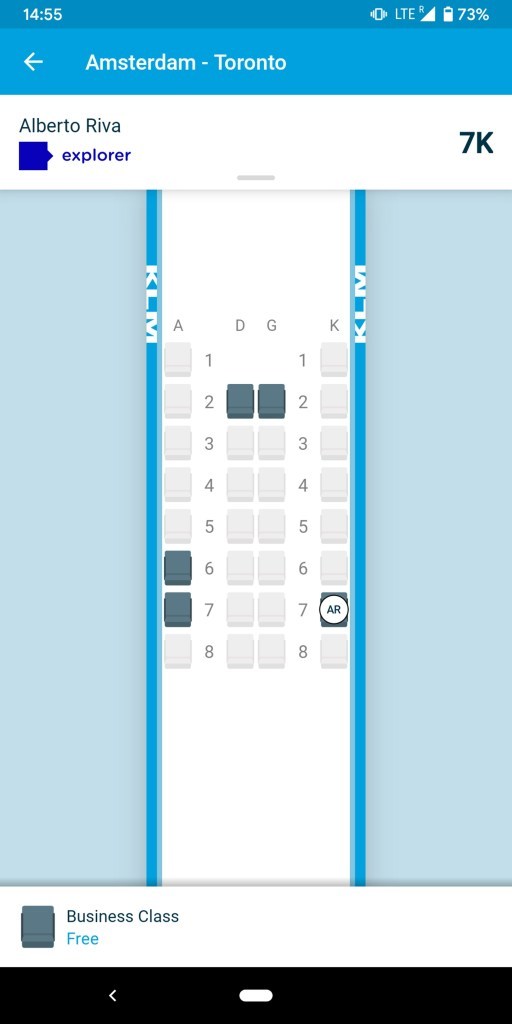
Ground Experience
TPG Rating
16/20
PH-BHP
Tail
1yr
Age
11%
Late
h 16m
Avg. Delay
17:45
Departure
7h 37m
Duration
Amsterdams Schiphol Airport is one of the easiest airports in Europe to navigate. Connections are a breeze compared to Paris Charles de Gaulle (CDG) or London Heathrow (LHR), getting there from the city is easy with plenty of trains and the airport itself is well designed.
When I arrived at the departures hall at 2:40 p.m. for the 5:35 p.m. departure to Toronto, I found the check-in area and departure gate already displayed on the monitors.
Biz-class passengers and elite members of the SkyTeam alliance could check in using a separate gated area, indicated by the SkyPriority logo.

Within this area were both traditional, staffed desks and self-service kiosks, useful if you dont have baggage to check. KLMs institutional blue color, with accents of Dutch orange, appeared in tasteful touches.


Despite having already checked in on the app, I got a paper boarding pass from a desk employee you never know when you might need it. Then I used the priority access to security and the departure gates, clearly indicated within the gated area.

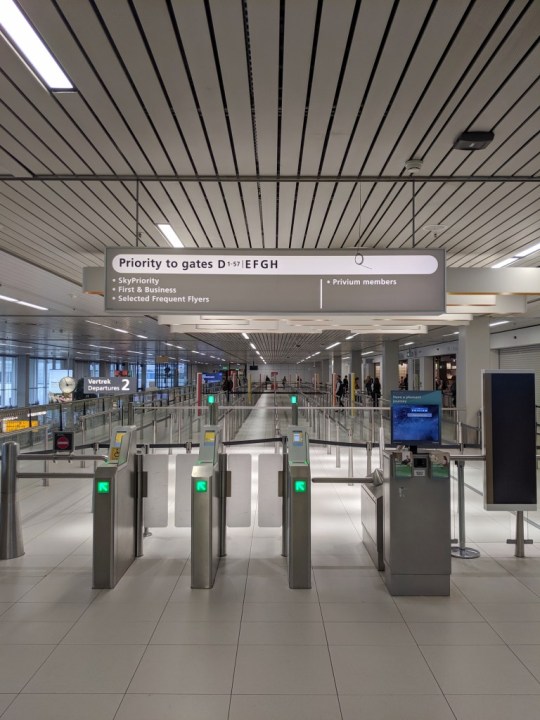
After a quick and painless security and passport check, I was out in the departures area, headed to a duty-free shop for the delicacies I always make sure to bring home from the Amsterdam airport stroopwafels, salty licorice, Gouda cheese and then to one of the KLM lounges.

Even without lounge access, I would have had plenty to see and quiet areas to sit in. Schiphol is a nice airport to be in if you dont have lounge access. Its also a quiet airport, with no announcements on loudspeakers.

TPG contributor Eric Rosen has reviewed in depth the renovated KLM Crown Lounge, one of the two at AMS (the other one is within the area restricted to flights within the European Unions passport-free zone.) Eric explains in detail what you can find there, but I can sum up my time in it with one word: Wow!
This was a far cry from the cavernous, rather boring space it used to be. It had been completely transformed into a large, world-class lounge.
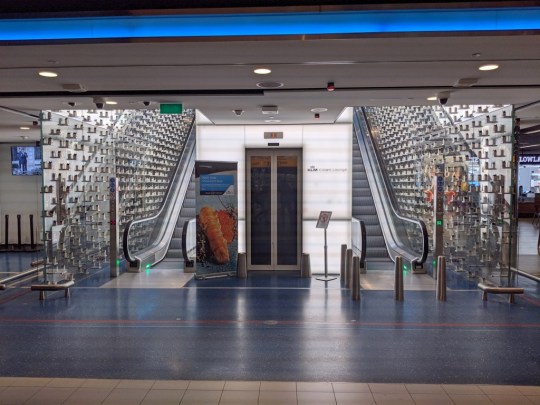
Immediately upon entering, I could see things had changed from my previous visits.
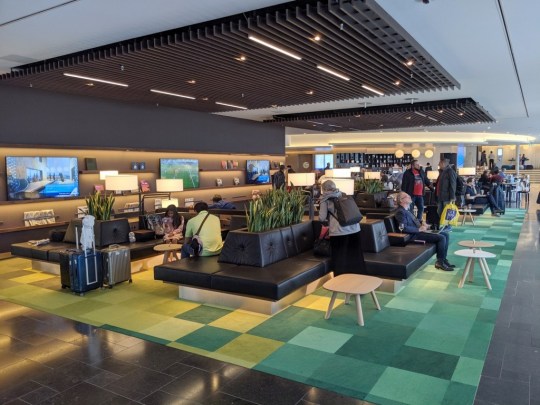
As befits the name, it now had lounge chairs. And much, much better food options, including an la carte restaurant on the second floor, called Blue. (Too bad it was not free, unlike the food and drink in the lounge.)
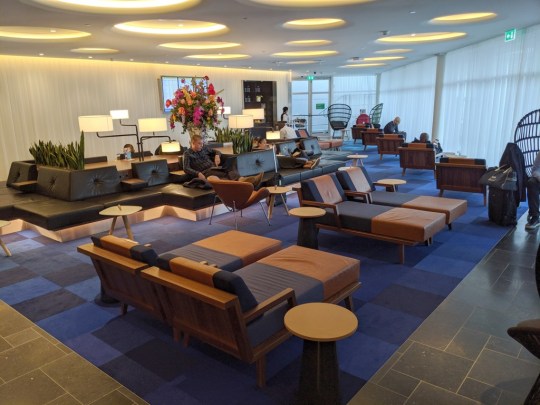
I spent a delightful hour exploring, and liking, the buffet food and the decor. Another reason to pick a transfer at AMS over other European gateways.
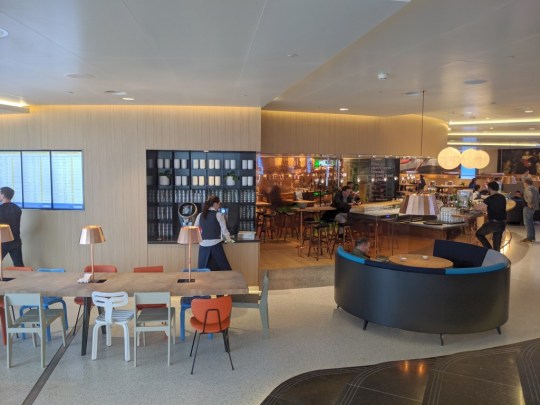
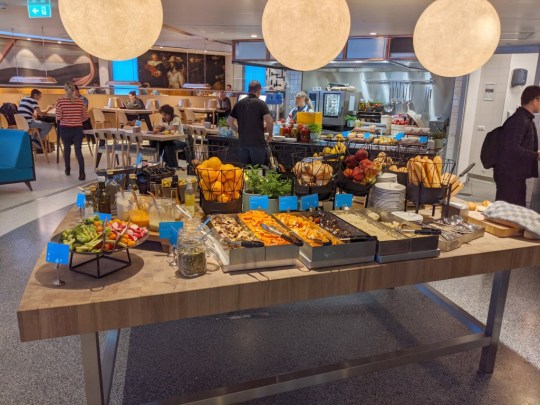
Monitors in the lounge included a mention of how long it took to walk to a specific gate. Armed with that knowledge, I could maximize my time in the lounge and timed my arrival at the gate just four minutes before the start of boarding, long enough to admire the beautiful blue 787-9 that was to fly as KL695 to Toronto.
KLM names its 787s after flowers, and this one, a year-old Dreamliner, was called Tulip. How much more Dutch can you get?
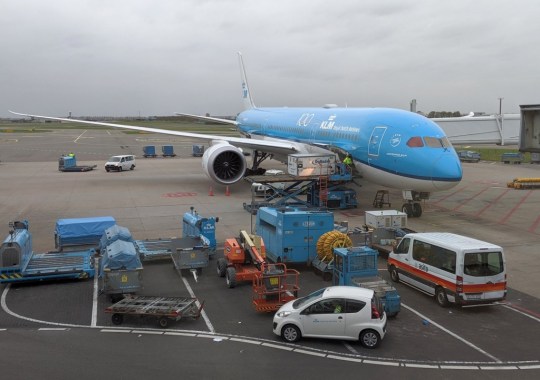
Priority and general boarding lanes were clearly marked, and nobody was crowding the boarding area. At 4:50 p.m., boarding began right on time.
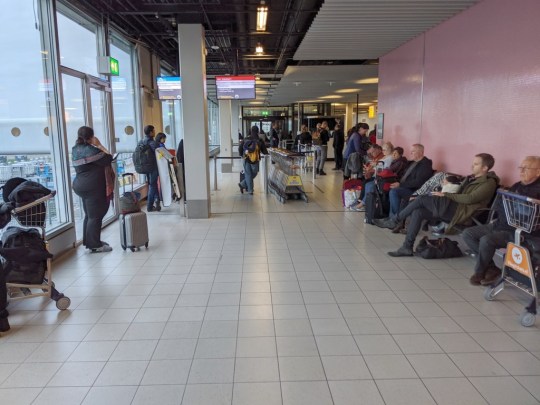
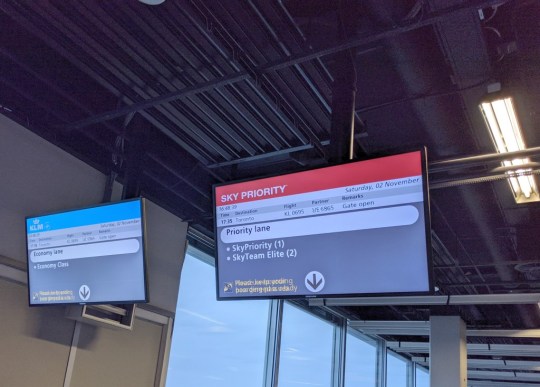
Cabin and Seat
TPG Rating
26/30
1-2-1
Configuration
81in
Bed Length
2
Lavs
KLMs 787-9 has 30 business-class seats, in a single cabin. The longer 787-10 has 38.
It was, even at first sight, a huge improvement over the 2-2-2 biz classes of previous KLM birds. The reverse-herringbone layout and that particular seat type have been around for years, but in KLMs incarnation, they exuded quiet elegance.
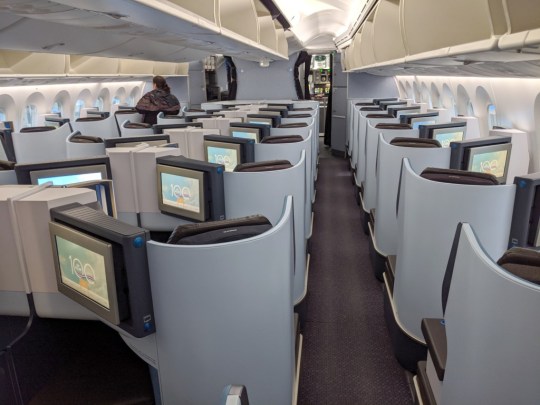
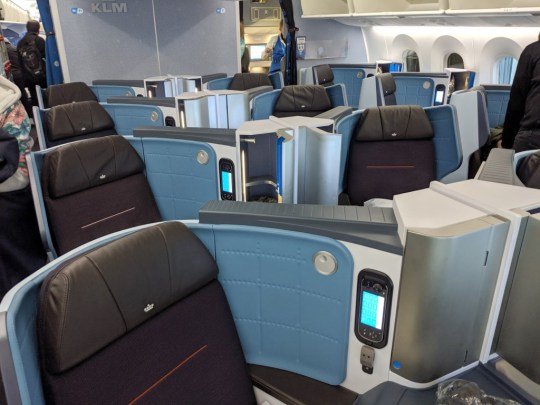
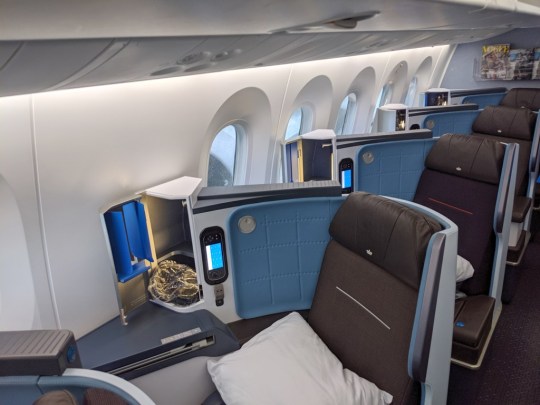
Of course, as is usual on this aircraft: No window shades! 787 windows are dimmed electronically, with the touch switch under them.
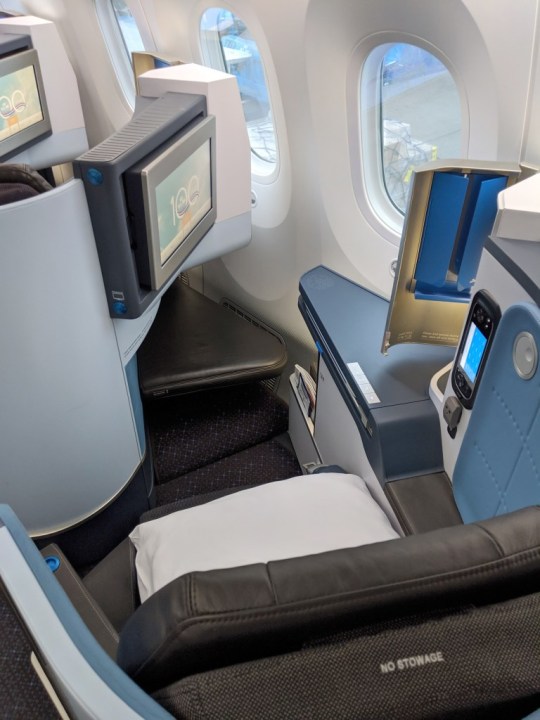
The inflight-entertainment screen swiveled out with a press of the blue button to the left.

Headrests were adjustable in height and angle, and had adjustable wings. The seatbelts had airbags, as happens more and more in premium seats.
In the lie-flat position, the 22-inch wide seat turned into an 81-inch bed. Though a mattress pad for sleeping was not available, the bed offered enough space in the footwell to move comfortably. The only thing I didnt like about it in bed mode was the clunky airbag belt, and the pillow could have been firmer, too.

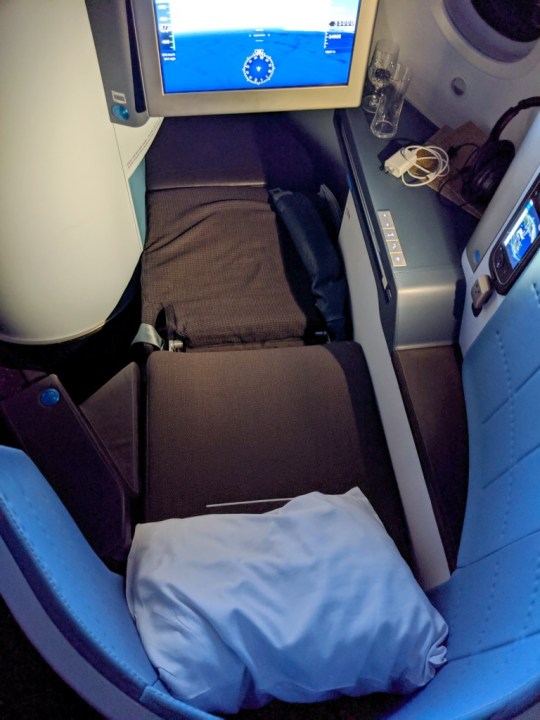
When sleeping under a blanket or comforter, fasten your seat belt over it. That way, if theres turbulence and flight attendants come to check if youre buckled in, they can just take a look and not bother you and youll make their job easier, too.
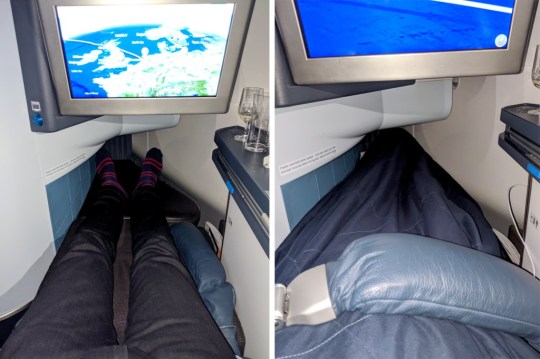
The armrest on the aisle side could be lowered with the blue button. Flight attendants asked passengers to keep them in the lowered position for takeoff and landing.
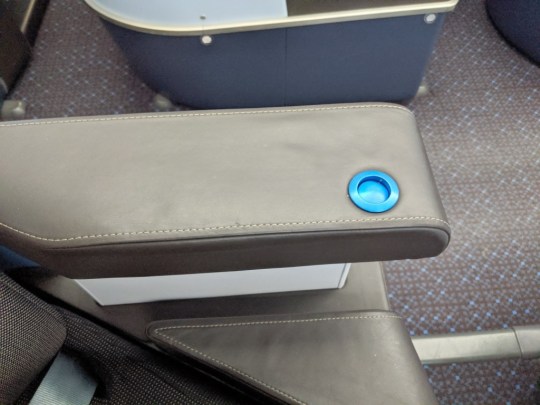
It would not have been possible to store large electronics like laptops or tablets anywhere other than the overhead bins, but the closed storage cubby next to the IFE remote was ideal for wallets, phones and other small items. Headphones for the IFE were hanging in it from a hook.

I especially liked the clever mirror inside the door, in classy KLM blue.
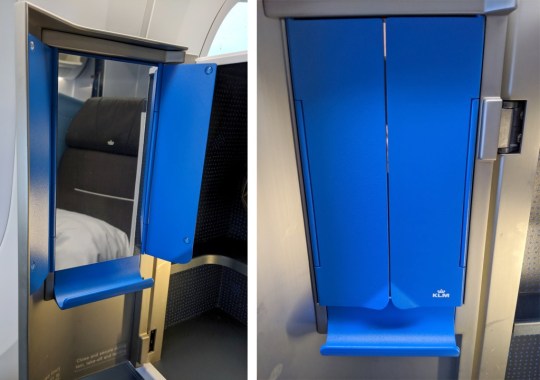
An international power outlet and powered USB outlet were under the armrest by the window, with a sign indicating their location.
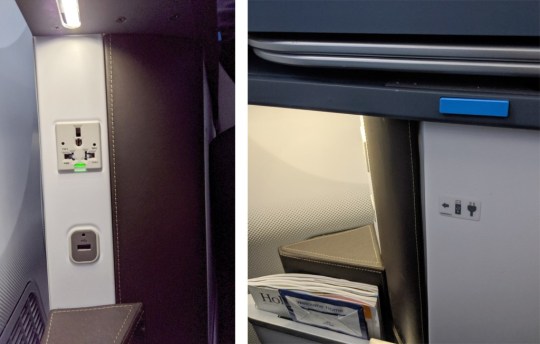
The tray table extended from the same armrest with the press of another blue button. It was a bit small, but still OK for a 15-inch laptop, and once extended it could slide forward, letting the seat occupant get up during meal service. This is a key element that not all airlines get right; for example, Virgins swanky new Upper Class forces you to stay seated when the table is out and a meal is on it.

The seat controls were intuitive, and I didnt see any other passenger have to ask a flight attendant for help figuring things out. From the top, the four buttons are: slide seat forward and back, bed mode, seat back up and overhead light.
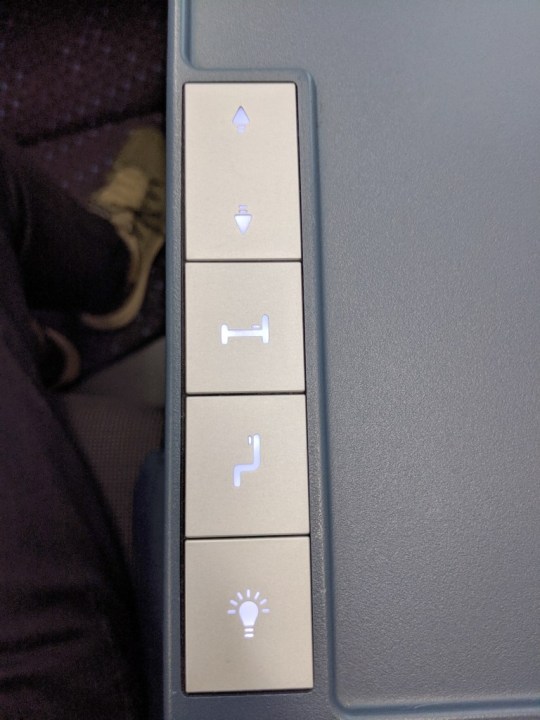
Besides the overhead light, which could be controlled from the remote too, there was a reading light built into the seat. Two adjustable air-conditioning vents were above the seat, the latter a feature not found on all aircraft. (Some European airlines, like Lufthansa, are notorious for keeping cabins far warmer than what Americans are used to.)
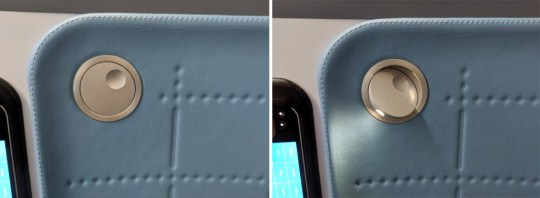
The bathrooms were more or less normal, save for a KLM classic, the Delft-house decorations. Theyre found all over its branded materials, and even on the escalator to the Crown Lounge.

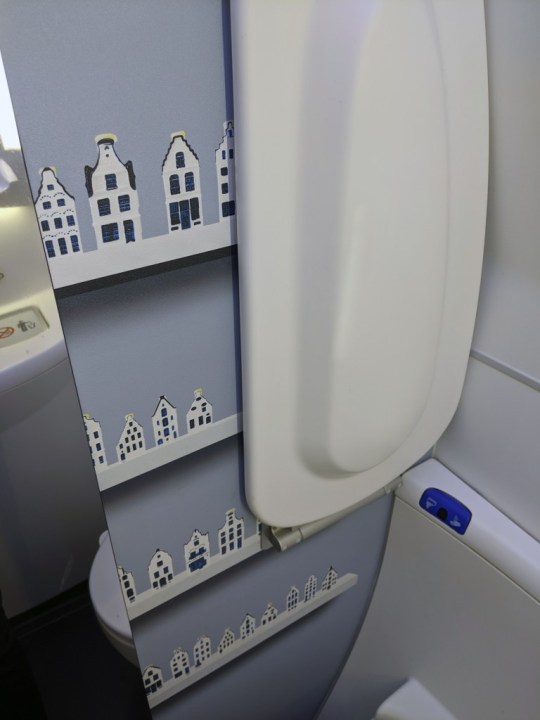
Amenities and IFE
TPG Rating
12/15
16in
Screen
250
Movies
200
TV Shows
No
Live TV
No
Tailcam
As customary, I found pillow and comforter already on the seat, and headphones in the mini storage locker. Amenity kits were distributed later.
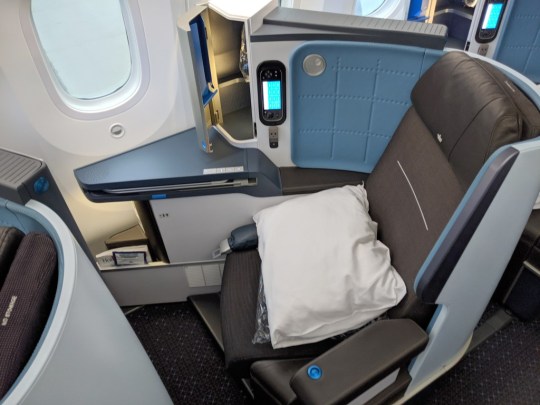
The amenity kit by Dutch designer Jan Taminiau, featuring the colors of the Dutch flag, was distributed to each passenger just after flight attendants closed the overhead bins prior to pushing back from the gate. It had the basics for a long-haul flight: socks, toothpaste and toothbrush, eye mask and earplugs, moisturizer, lip balm and a pen useful for immigration forms.

More toiletries were found in the two bathrooms exclusive to business class, which were spotless throughout the seven-hour, 40-minute flight. Hair gel, body mist and hand-and-body lotion were a limited edition by Rituals for KLM. Besides the pillow and comforter, I didnt receive any other amenities like slippers or pajamas.
These KLM aircraft feature crisp, 16-inch screens, with about 250 movies to watch in at least 14 languages, and a gorgeous moving map: this was a good IFE, and I enjoyed it thoroughly.
The Wi-Fi internet disconnected a few times, but was otherwise quite usable. I paid 18 euros ($20) for the whole flight, a much better deal than the other choice of 8 euros ($9) for one hour. (If you just wanted to send or receive text messages, that was free.) The Speedtest app kept timing out, but the internet was fast enough for videos, albeit with some buffering.
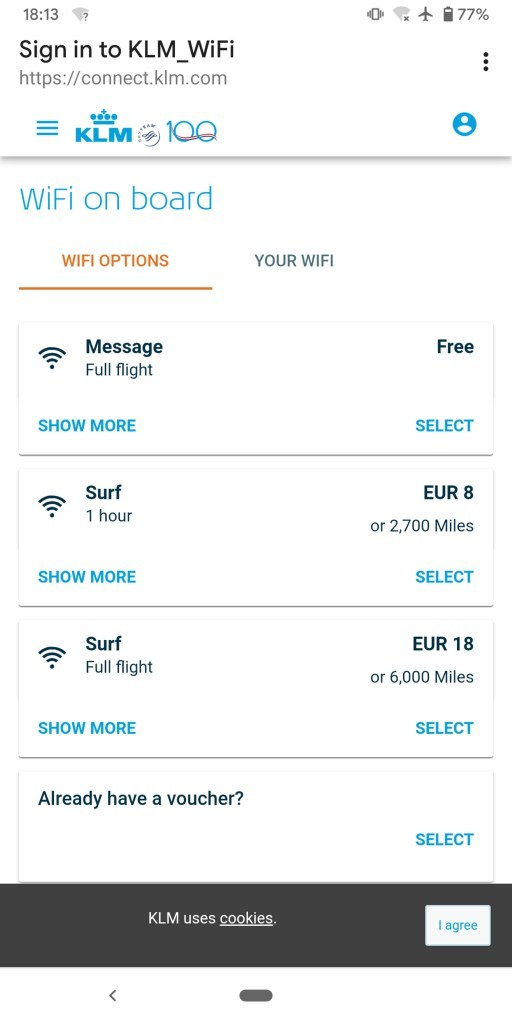
The headphones supplied by the airline were of the fairly rare three-prong kind, with OK not outstanding sound quality.

The beautiful 3D moving map could also be loaded on the smaller display in the remote, which retained full pinch-and-zoom functionality.

The cockpit-view function is increasingly popular in IFEs, and for aviation geeks its a delight every time. After our takeoff on schedule at 5:45 p.m., I followed on the screen our climb from sea level straight to our initial cruising altitude of 36,000 feet in 25 minutes which happened in near silence, despite my position just in front of the righthand engine.

The flight unfolded entirely in darkness. In late June, say, the views out of the window would have been spectacular, one long sunset seen from the edge of the stratosphere, but in early November we flew at night from start to end.
Food and Beverage
TPG Rating
15/20
2
Meals
Nicolas Feuillatte Brut Rserve
Champagne
No
Dine on Demand
Are you even flying on a Dutch airline if youre not offered a Heineken? Of course not, and a can of the national beer of the Netherlands was on the tray that a flight attendant brought down the aisle as boarding finished. There were also Champagne, orange juice and water. (Incidentally, the two stripes on the flight attendants sleeve identified her as a senior cabin attendant in the KLM rank insignia system.)
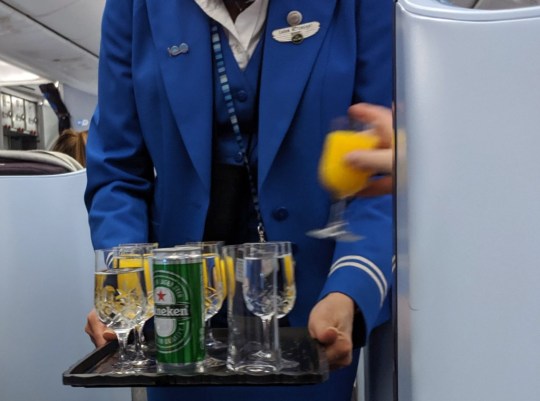
At my seat, I found a menu and wine list, with the KLM logo inside a Delft-porcelain motif. The airlines Champagne may have been a midrange Nicolas Feuillatte Brut Rserve, but its taste in graphics was impeccable.

On the wine list, I noticed a cocktail described as a special lighter, crisper version of a Negroni, with Dutch genever (a typically Dutch kind of gin), chosen because both KLM and the Negroni were born in 1919. When the drinks cart arrived at my seat, half an hour after takeoff, I asked for it, with a small bowl of nuts and sparkling water.
The nuts should have been warm and the drink in a wider glass, but those are minor quibbles to have at 36,000 feet, and the Negroni-ish was indeed lighter and crisper than the original, a true pleasure.

For dinner, I could choose among two appetizers, three entrees and two desserts. For the appetizer, I had tomato soup over the other choice, salmon and spicy mango with hazelnut-cucumber-pepper-and-mango dressing.
All three main courses featured potatoes, in an apparent nod to a classic Dutch staple food. My choice was panfried cod and Dutch prawns with herb potatoes, roasted sweet potatoes and broad beans in a mussel gravy. The other two entrees were miso-marinated chicken thigh with carrots, potato puree, Brussels sprouts in an orange beurre blanc sauce; and beef stew with red cabbage, potatoes and cornichons.
For dessert I could have a cheese plate blue cream cheese, Klaver Roem and Leerdammer Caractre, all Dutch cheeses, served with crackers and grapes or sweet bites: brownie with ganache, a chocolate-caramel tartlet and a lemon cheesecake with raspberries. I went with the cheese, and a glass of New Zealand riesling from a simple, five-wine list. It also featured a Chilean chardonnay and three reds: a grenache from France, an Argentinian malbec and a South African shiraz.
Things sounded promising on paper. But when dinner service began, they went awry.
The galley ran out of the salmon appetizer for everybody who wanted it, and flight attendants proposed alternatives to at least two passengers. This happens, I said to myself, no biggie. Space on board is limited, and not everybody gets their first choice on every flight. In any case, I had the tomato soup, which was very good, and though the salad was a bit wilted, it came with a zingy beetroot dressing that was as cheeky as the salt and pepper shakers in the shape of Dutch clogs.

But then I waited 30 minutes between the appetizer and entree, and the flight attendant assigned to my aisle got confused and thought I had ordered the chicken, not the cod.
They hadnt loaded enough cod anyway, he said, seeming a little confused about what was going on in his galley, but after some inquiry he turned up one stray cod entree for me. And good thing he did, because it went beautifully with the riesling.

The silverware had pretty inlaid handles, and the carts were ornamented with the same motif as the menus.

With dessert, the flight attendant brought around a box of chocolates in the shape of, you guessed it, Delft houses. I had two, and I could have had more. They were excellent, and so were the cheeses. By the time I was done with all of it, though, it had been a 90-minute dinner, and when your flight is under eight hours and at night, you may want a service flow that maximizes sleep instead of time spent eating.

A half hour later it was lights out in the cabin, when we were already nearing the southern tip of Greenland, four and a half hours out from Toronto.
Ninety minutes before landing, after some sleep, it was time for the second meal service. The appetizer was a sweet-potato salad with white cheese and pomegranates, followed by either a cheese quiche or an Angus beef burger with cheese, and then by an apple pie. The meal was served with pepper jelly and deep-fried onions on the side. I got the burger and a Coke, which proved to be a good choice. And the apple pie that followed was perfectly warm.
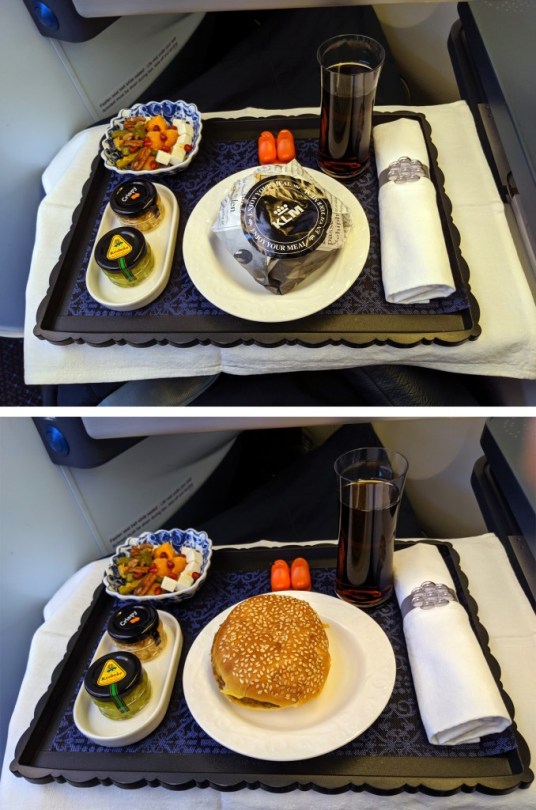
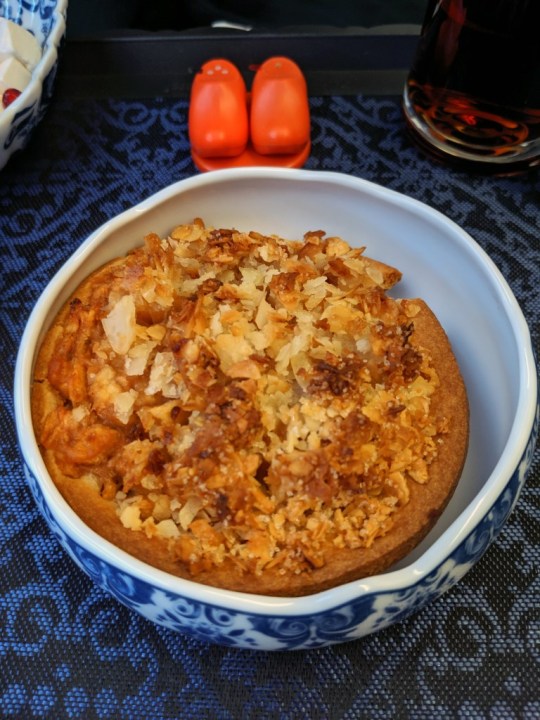
KLM did not let me go hungry. It wasnt top-quality, but it was perfectly competent airplane food, in abundant amounts.
Service
TPG Rating
11/15
No
Extra Pillows
No
Turndown Service
Would you like a house, Mr. Riva? the flight attendant asked me after the last dish had been removed from my tray. On any other airline, I would have thought that a weird question, but in KLM business class it could mean only one thing. It was time for the distribution of the miniature Delft porcelain houses filled with liquor, which the airline gives away as souvenirs to business passengers.
The one distributed on KL695 that day wasnt any old house, either.
Its the house where our king and queen live, he said.
According to the booklet that came with it, Huis ten Bosch is the residence of King Willem-Alexander, Queen Mxima and their children. Thats the very king who occasionally moonlights as a KLM pilot, but there was no royalty at the controls on my flight: His Majesty is qualified on the Boeing 737, not the 787.
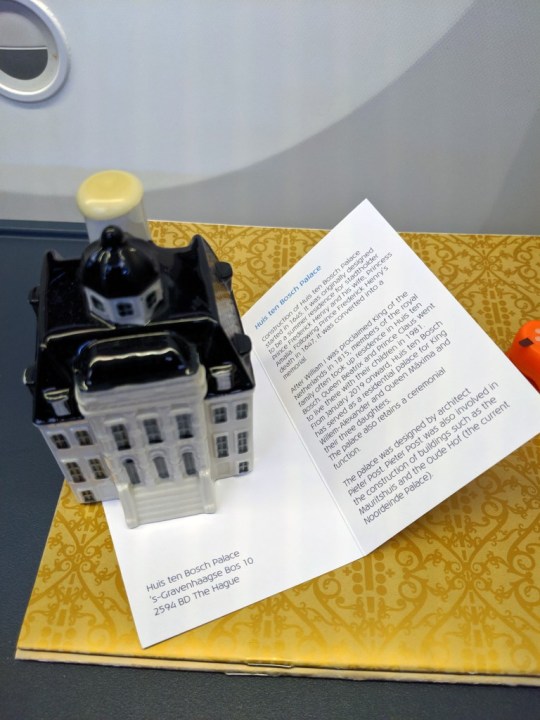
That very nice interaction with the flight attendant and the story behind the Delft house ended the flight on a high note for me, but overall, the service was OK, not great. There were moments of slight confusion during meal services, and dinner lasted way too long.
Overall impression
You dont need to be an aviation enthusiast to see how pretty this 787 was on the inside and out, and even a casual flyer notices the Dreamliners smooth, quiet ride. Add a very good biz-class seat, and you have the makings of a very nice Atlantic crossing.
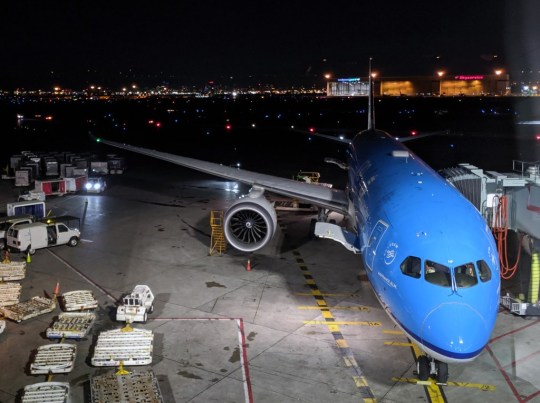
Coming off the flight on a cold night in Toronto, I reasoned that Id just flown in a better biz seat than most Delta One seats, certainly better than any Lufthansa seat short of first class, and on par with the best seats offered on KLMs sister airline, Air France. It would just have needed better service to compete for greatness. That said, you would not be disappointed if you redeemed a reasonable number of miles for KLM biz class on the Dreamliner.
All photos by the author.
Arplis - News source https://arplis.com/blogs/news/great-seat-so-so-service-a-review-of-klms-business-class-on-the-787-9-from-amsterdam-to-toronto
0 notes
Link
via Today Bharat On August 28, Peddulu was reunited with his family in Jagtial district of Telangana. As the airplane took off the tarmac at Dubai international airport and the seat-belt sign went off, 35-year-old Jangili Peddulu heaved a sigh of relief. He was ecstatic, thankful to his fate, even as a montage of troubling images from the last five years flashed before his eyes. At last, he was going to meet his family in a few hours. Five days earlier, on August 21, he was stopped by immigration officials at the same airport and prevented from flying out of the country, for he had only an emergency certificate or temporary passport and not the UAE administration’s exit permit to leave. Without wasting time, as soon as the airplane took off, he requested his co-passenger at the window seat for a few aerial photographs and video of “the impossible city”, a city where an individual like him, as he believed, could have become someone through sheer hard work. He is not sure if he could ever return even if he wished to. On August 28, Peddulu was reunited with his family in Jagtial district of Telangana. Now in the comforts of his residence, by the side of his wife, aging father, and schoolgoing children, Peddulu advises friends and acquaintances to never do what he had done. “I want to ask everyone to travel to the Gulf only after securing valid employment and travel documents, and never trust an agent,” Thanks to an ongoing amnesty scheme that was rolled out by the UAE administration in the wake of rising coronavirus cases, allowing all foreign nationals with VISA expired before March 1 to leave the country without a penalty or prosecution. The short-term amnesty that began on May 18 and was to end on August 18 has now been further extended till November 17. “Since May, I have been trying to come back home. Ever since the coronavirus pandemic struck Dubai, thousands of people like me had been out of work. It was a complete shutdown,” says Peddulu. He says during this period he had to borrow Rs 25,000 from home and another Rs 60,000 from a friend to clear personal dues before returning home. In Bur Dubai, Jytha Narayana, a social worker who also hails from Jagtial district of Telangana, has been running from pillar to post to help irregular migrants like Peddulu safely return home. Irregular migrants, in human rights parlance, refer to those who have been overstaying in a country. Speaking to indianexpress.com over the telephone, he says he is working currently with at least 40 migrants who had “accidentally” crossed over to Dubai from Muscat and are waiting to return home by making use of the amnesty. Most people do not have a single document to prove even their nationality, he says. “When we go to the Indian Consulate in Dubai, we should at least have documents to prove their Indian nationality. We need to get a clearance certificate from the police station concerned stating there are no active criminal cases against the applicant. In Peddulu’s case, it took three full months before he could get an emergency outpass,” says Narayana. A majority of such migrants wishing to return home are from Telangana and Andhra Pradesh, he says. Swadesh Parkipandla, a resident of Jagtial and the president of Pravasi Mithra Labour Union, said in the case of such irregular migrants, a certificate is required from the district collector of the applicant’s native district in India to prove his/her nationality. In a similar case recently, the wife of another man stranded in Dubai after having crossed over from Oman four years ago appealed to the Jagtial district administration to coordinate with the Centre and the Indian Consulate in Dubai to facilitate his safe return. On August 8, along with the volunteers of the Union, Mulkala Jyothi pleaded that her husband Sathyam be brought back home. Sathyam has been working in Dubai as an irregular migrant worker and wished to return home in wake of the pandemic. According to Parkipandla, there are hundreds of irregular migrants, like Sathyam, wishing to return home. Hyderabad-Mumbai-Muscat and then Dubai Peddulu’s trysts with the Gulf started in 2010 when he first travelled to Saudi Arabia in search of a job but had to return a month. As a tractor driver in Jagtial, he was earning around Rs 6000 a month. But dreams of a better standard of living for his family once again prompted him to travel to Dubai in 2011. This time, he stayed in Bur Dubai along with several others from Telangana, did painting, welding, gardening, and everything that came his way. As a houseboy he was earning a monthly income of around Rs 60,000, six times higher than what he used to earn back home, and managed to send home nearly half of that. Later, according to him, it was when he wanted to visit his family back home that he realised that his VISA had long expired. By then, after running away from his original sponsor he had been overstaying in the country for 18 months. He was sent to jail for three days and then deported with a hefty penalty. For him, return to the village was merely physical as his mind stayed back in Dubai. The jobs back at home were no match to Dubai, in terms of the remuneration. At the same time, having been deported there was no way he could go back. Even after returning, Peddulu was in touch with people in Dubai. As time passed, his desperation was felt by some who offered to help. In 2015, he managed a visit-visa stamp for Muscat on his passport. The Oman capital was hardly the destination. “I was in touch with friends in Dubai who put me in touch with a local agent in Jagtial who, in turn, connected me to a few men from Kerala in Muscat,” he said. “It was a total package of travel from Jagtial to Dubai. I paid around Rs 1.10 lakh without enquiring about the entire details.” When he reached Muscat, the Keralites took his original passport and gave him another passport with a Muslim identity. Along with 10 others, Peddulu says he was put up in a room for the next 15 days. As it was the month of Ramzan, they mostly stayed indoors. In groups of two or three, they were shifted to Dubai in vegetable vans. “We took the highway. At the border, when the armed guards checked the vehicle and spoke to the driver in Arabic we knew anything could have happened.” It was a relief once the vehicle reached Dubai. He had already lived in Dubai for three years. He worked as a “houseboy” in several houses, worked odd-jobs making a decent living for his family back home till the pandemic struck the city. Risking life for better livelihood According to Mandha Bheem Reddy, a senior migrant rights activist and the president of Emigrants Welfare Forum, while many are cheated by organised criminals, many migrant workers have died at the Oman-UAE border when the military on either side opened fire at them. In May 2012, Durgam Bheemaiah of Velagatoor in Jagtial district was allegedly shot dead by Oman’s border security forces while he was crossing the border from Muscat to Dubai. He had gone to the Gulf in search of livelihood and ran away from his sponsor in Dubai to Oman. “He was an irregular migrant in Oman, and he was unable to pay the heavy penalty. So he chose the desert way to come back to India via Dubai,” says Bheem Reddy, adding that for over eight years the family has been awaiting an ex gratia amount from the government, but in vain. “Whether these migrants are taking this path knowingly or unknowingly, it is certain that the motive is to earn a better living for their families,” says Bheem Reddy pointing out that nearly 90 per cent of those who opt this route are senior migrants who have already lived and worked in Dubai for several years. In many cases, workers run away from their sponsors in search of better remuneration, become overstayers in that country, and face a “life ban” for violating local laws while returning to their home country. “The government will take their biometrics and deport them permanently. It is usually these immigration deportees who crossover from Oman to Dubai to rejoin their once gainful employment or even work as part-time as houseboys, car washers, etc which are quite lucrative.” Forgery, Impersonation and illegal use of passport On his return to Mumbai, Peddulu was briefly detained and questioned by the immigration officials at Mumbai International Airport based on a lookout circular issued against him. Days after he had traveled to Muscat in 2015, the Dabolim Airport Police Station in Goa arrested a 31-year-old man named Syed Baseer Ahmed, a native of Tamil Nadu, on charges of forgery, impersonation and utilising the genuine passport issued to Peddulu, by replacing the photograph. According to a summons notice from the Goa police dated September 14, 2015, Peddulu is a witness in the case. According to another notice, dated 26 July, 2016, the Regional Passport Officer-Hyderabad, had sought a written explanation from Peddulu regarding his passport found being used by another person. Failure to explain could result in action against him under the Passport Act, 1967. “At the airport, he was served a notice under Section 41 CrPC directing him to cooperate in the investigation and released on a personal bond. He is suspected of having sold his passport. In this case, it was another Indian who returned or else it could have been anyone. That is a threat to national security,” said Bheem Reddy. Migrants rights activists have been voicing out against organised human trafficking of workers who end up in a foreign country as ‘irregular migrants’ without any access to health or justice. They urged the government to thoroughly investigate such cases so as to prevent it.
0 notes
Text
North America Smart Airport Market Size Key Manufacturers, Development Trends and Competitive Analysis
The North America Smart Airports Market size is expected to reach USD 7.74 billion by 2026 according to a new study by Polaris Market Research. The report “North America Smart Airport Market Share, Size, Trends, Industry Analysis Report By Technology Type (Security Systems, Communication Systems, Passenger, Cargo & Baggage Ground Handling Control, Air/Ground Traffic Control, Endpoint Devices) Component Type (Hardware, Software, Services); By Application Type (Aeronautical Operations, Non-Aeronautical Operations), By Location Type (Landside, Airside, Terminal Side); By Regions, Segments & Forecast, 2020 – 2026” gives a detailed insight into current market dynamics and provides analysis on future market growth.
Passengers usually face problems in airport regarding long queues, waiting lines, security check-ins, less real-time information, flight delays, less space in airport, lack of proper customer service, improper baggage handling, lost baggage complaints and lack of facilities for overcoming all these problems airports across the globe are heading towards smart airport for providing better and seamless personalized experience to passengers. Growing demand of automated and self-service processes and growing demand of real time information in airport is driving North America smart airport market.
Request for a sample copy of this research report @ https://www.polarismarketresearch.com/industry-analysis/north-america-smart-airport-market/request-for-sample
Smart airport security system technology is driving the market as various airports are implementing new innovative smart components such as, flight booking management, automatic check-in, way finding services to automated security checks and border control. The substantial growth prospects of the smart airport market can be attributed to the efforts undertaken by airports across the globe to enhance their business processes and provide optimized services. Airport operators are investing heavily on IT and digital technology for enhancing customer experience. Furthermore, smart airport landside location is adopting digital technologies such as, transport synchronization, real-time flight information, advanced booking and intelligent passenger steering for enhancing passenger experiences and other features. Moreover, Airside is upgrading in various domain such as, In-wallet scanning, geolocation of vehicles and coordination of vehicles with real time information of landing aircrafts. Modernization of old airports, introduction of new airports, development in commercial aviation, and increasing focus on green initiatives are the key growth drivers expected to boost market for smart airports in North America.
Cyber security threats are the major concern which may bother passengers in sharing their details with the smart airport system. Also, unauthorized usage of the system poses a threat to the airport administration IT solutions, central reservation systems, and passenger name records. It also includes unauthorized modification of software and hardware or any IT and communication system. Physical attacks in the form of vandalism, sabotage and explosives on airport assets can result in losses to the stakeholders and assets. Furthermore, human error is also one of the biggest threat which is caused by network administrators. Configuration errors can negatively impact security or operations in the form of cancelled flights, and system down time. Similarly end users, such as, airport employees can make errors by filling wrong passenger information.
The North American smart airports market was dominated by the US in 2018, however Canada is expected to witness faster growth during the forecast period. As US has the busiest airports, and the flying volume is increasing at a substantial rate each year, many airports here are in need of better ways to process the flyers. Implementation of robotics, artificial intelligence and machine learning is currently in trend in the US aviation industry. In Miami international airport, beacons technology is used for sending message and guiding location to passenger through navigation. The technology is helping airport in determining where passengers are congregating, and it further enhances in indoor mapping and sending relevant information to customers.
According to Architectural Record published in 2019, over 50 airports in the US are collectively projected to account for up to $70 billion in construction projects in the next three years. These projected not only focuses on renovation and modification, but also aims to refurbish, manufacture, install and operate the ITT systems. Furthermore, Canadian airports observed a 6.3% increase in overall traffic and a 9.8% increase in international footfall in 2017. This increasing passenger inflow has generated a greater need towards advanced technologies and thus is driving the growth of smart airports market in this region. Companies such as
The key players in the market include Amadeus IT Group S.A., Cisco Systems, Inc., Honeywell International Inc., International Business Machines (IBM) Corporation, QinetiQ Group Plc, Sabre Corporation, Siemens AG, Rockwell Collins Inc., Thales Group, and T Systems International GmbH among others.
Complete Summary with TOC Available @ https://www.polarismarketresearch.com/industry-analysis/north-america-smart-airport-market
Polaris Market research has segmented the North America Smart Airport market report on the basis of technology, component, application, location and countries
North America Smart Airports Technology Outlook (Revenue, USD Million, 2016 – 2026)
Alerts & Cyber Security
Biometrics
E-Fence and Ground Surveillance Radar
Behavioral Analytics
Others
Wireless Airports
Smartphones for Communication
Near Field Communication
Social Media
Interactive Advance Passenger Information
RFID Baggage Reconciliation System
iBeacons
E-Passport Gates
Automated Control of Operations
Digital Navigation
Surveillance Radar
Sensors
Tags
Other Devices
Airport Management Software
Digital Signage
North America Smart Airports Component Outlook (Revenue, USD Million, 2016 – 2026)
Hardware
Software
Services
North America Smart Airports Application Outlook (Revenue, USD Million, 2016 – 2026)
Aeronautical Operations
Non-Aeronautical Operations
North America Smart Airports Location Outlook (Revenue, USD Million, 2016 – 2026)
Landside
Airside
Terminal Side
North America Smart Airports Country Level Outlook (Revenue, USD Million, 2016 – 2026)
U.S.
Canada
Purchase This Report @: https://www.polarismarketresearch.com/checkouts/6491
About Polaris Market Research
Polaris Market Research is a global market research and consulting company. The company specializes in providing exceptional market intelligence and in-depth business research services for our clientele spread across different enterprises.
Contact Us:
Polaris Market Research
Phone: 1–646–568–9980
Email: [email protected]
Web: www.polarismarketresearch.com
#North America Smart Airport Market#North America Smart Airport Market share#North America Smart Airport Market size
0 notes
Text
North America Smart Airport Market Current Trends and Challenges Analysis By 2026
The North America Smart Airports Market size is expected to reach USD 7.74 billion by 2026 according to a new study by Polaris Market Research. The report “North America Smart Airport Market Share, Size, Trends, Industry Analysis Report By Technology Type (Security Systems, Communication Systems, Passenger, Cargo & Baggage Ground Handling Control, Air/Ground Traffic Control, Endpoint Devices) Component Type (Hardware, Software, Services); By Application Type (Aeronautical Operations, Non-Aeronautical Operations), By Location Type (Landside, Airside, Terminal Side); By Regions, Segments & Forecast, 2020 – 2026” gives a detailed insight into current market dynamics and provides analysis on future market growth.
Passengers usually face problems in airport regarding long queues, waiting lines, security check-ins, less real-time information, flight delays, less space in airport, lack of proper customer service, improper baggage handling, lost baggage complaints and lack of facilities for overcoming all these problems airports across the globe are heading towards smart airport for providing better and seamless personalized experience to passengers. Growing demand of automated and self-service processes and growing demand of real time information in airport is driving North America smart airport market.
Request for a sample copy of this research report @ https://www.polarismarketresearch.com/industry-analysis/north-america-smart-airport-market/request-for-sample
Smart airport security system technology is driving the market as various airports are implementing new innovative smart components such as, flight booking management, automatic check-in, way finding services to automated security checks and border control. The substantial growth prospects of the smart airport market can be attributed to the efforts undertaken by airports across the globe to enhance their business processes and provide optimized services. Airport operators are investing heavily on IT and digital technology for enhancing customer experience. Furthermore, smart airport landside location is adopting digital technologies such as, transport synchronization, real-time flight information, advanced booking and intelligent passenger steering for enhancing passenger experiences and other features. Moreover, Airside is upgrading in various domain such as, In-wallet scanning, geolocation of vehicles and coordination of vehicles with real time information of landing aircrafts. Modernization of old airports, introduction of new airports, development in commercial aviation, and increasing focus on green initiatives are the key growth drivers expected to boost market for smart airports in North America.
Cyber security threats are the major concern which may bother passengers in sharing their details with the smart airport system. Also, unauthorized usage of the system poses a threat to the airport administration IT solutions, central reservation systems, and passenger name records. It also includes unauthorized modification of software and hardware or any IT and communication system. Physical attacks in the form of vandalism, sabotage and explosives on airport assets can result in losses to the stakeholders and assets. Furthermore, human error is also one of the biggest threat which is caused by network administrators. Configuration errors can negatively impact security or operations in the form of cancelled flights, and system down time. Similarly end users, such as, airport employees can make errors by filling wrong passenger information.
The North American smart airports market was dominated by the US in 2018, however Canada is expected to witness faster growth during the forecast period. As US has the busiest airports, and the flying volume is increasing at a substantial rate each year, many airports here are in need of better ways to process the flyers. Implementation of robotics, artificial intelligence and machine learning is currently in trend in the US aviation industry. In Miami international airport, beacons technology is used for sending message and guiding location to passenger through navigation. The technology is helping airport in determining where passengers are congregating, and it further enhances in indoor mapping and sending relevant information to customers.
According to Architectural Record published in 2019, over 50 airports in the US are collectively projected to account for up to $70 billion in construction projects in the next three years. These projected not only focuses on renovation and modification, but also aims to refurbish, manufacture, install and operate the ITT systems. Furthermore, Canadian airports observed a 6.3% increase in overall traffic and a 9.8% increase in international footfall in 2017. This increasing passenger inflow has generated a greater need towards advanced technologies and thus is driving the growth of smart airports market in this region. Companies such as
The key players in the market include Amadeus IT Group S.A., Cisco Systems, Inc., Honeywell International Inc., International Business Machines (IBM) Corporation, QinetiQ Group Plc, Sabre Corporation, Siemens AG, Rockwell Collins Inc., Thales Group, and T Systems International GmbH among others.
Complete Summary with TOC Available @ https://www.polarismarketresearch.com/industry-analysis/north-america-smart-airport-market
Polaris Market research has segmented the North America Smart Airport market report on the basis of technology, component, application, location and countries
North America Smart Airports Technology Outlook (Revenue, USD Million, 2016 – 2026)
Alerts & Cyber Security
Biometrics
E-Fence and Ground Surveillance Radar
Behavioral Analytics
Others
Wireless Airports
Smartphones for Communication
Near Field Communication
Social Media
Interactive Advance Passenger Information
RFID Baggage Reconciliation System
iBeacons
E-Passport Gates
Automated Control of Operations
Digital Navigation
Surveillance Radar
Sensors
Tags
Other Devices
Airport Management Software
Digital Signage
North America Smart Airports Component Outlook (Revenue, USD Million, 2016 – 2026)
Hardware
Software
Services
North America Smart Airports Application Outlook (Revenue, USD Million, 2016 – 2026)
Aeronautical Operations
Non-Aeronautical Operations
North America Smart Airports Location Outlook (Revenue, USD Million, 2016 – 2026)
Landside
Airside
Terminal Side
North America Smart Airports Country Level Outlook (Revenue, USD Million, 2016 – 2026)
U.S.
Canada
Purchase This Report @: https://www.polarismarketresearch.com/checkouts/6491
About Polaris Market Research
Polaris Market Research is a global market research and consulting company. The company specializes in providing exceptional market intelligence and in-depth business research services for our clientele spread across different enterprises.
Contact Us:
Polaris Market Research
Phone: 1–646–568–9980
Email: [email protected]
Web: www.polarismarketresearch.com
#North America Smart Airport Market#North America Smart Airport Market size#North America Smart Airport Market share
0 notes